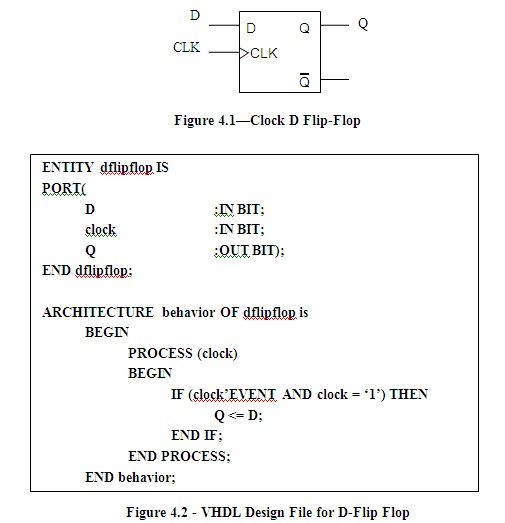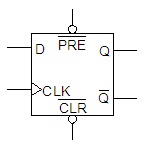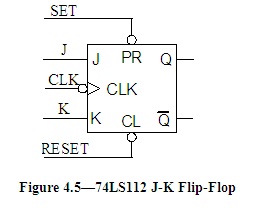Reference no: EM131081293
OBJECTIVES
1. To simulate the operation of a circuit used to create an edge-triggered D flip-flop.
2. To test the operation of a 74LS74 D flip-flop and compare the operation with the predicted behavior.
3. To describe and simulate the operation of edge-triggered D-type and J-K flip-flops using VHDL.
4. To test the operation of a 74LS112 J-K flip-flop and compare the operation with the predicted behavior.
PARTS LIST
Quartus II Design Software-Version 9.1
Frequency Generator
Oscilloscope
Parts:
1-Red LED 1 - Green LED
1-74LS112 dual J-K flip-flop 1-1.0 kΩ resistor, ¼ W 2-330 Ω resistors, ¼ W 1-SPDT Switch, DIP configuration
INTRODUCTION
Edge-triggered devices react only on a signal transition, either low-to-high (rising edge) or high-to-low (falling edge). This allows for the development of logic circuits in which the action of the components only occurs at a specified point in time. These circuits generally use a common signal, called a clock, as the trigger. These circuits are called synchronous.
Flip-flops can have two different types of inputs. Inputs that are used on clock transitions are called synchronous inputs; inputs that cause a change in the output independent of the clock are called asynchronous.
Synchronous inputs must be stable for some time before a clock transition to ensure the flip-flop will properly react. If the synchronous input changes too close to the clock transition, the flip-flop may miss or misinterpret the input. The time required for the input to precede the clock transition is called the set-up time.
Many of the VHDL features required for the description of sequential (clocked) circuits are covered in the Lecture Notes. The use of the PROCESSfunction allows for the step-by-step evaluation of a circuit and the ability to model clocked designs.The function needed to model the action of clocked circuits is called EVENT. The EVENT function can be combined with other operators to create an attribute. By combining an apostrophe with EVENT, the attribute 'EVENT is created. The 'EVENT attribute can be added to a signal to create acondition to detect a clock transition.
The 'EVENT attribute can only be used within a process.The commandclock'EVENT indicates, when true, that a transition has occurred on the input called clock. With the use of an IF operator, this can be used to indicate a clock edge. The statement IF (clock'EVENT AND clock = '1') will be true only on the rising edge of the clock. A falling edge trigger would occur for the statement IF (clock 'EVENT AND clock = '0').
As an example of a clocked circuit, consider the D flip-flop show in Figure 4.1and the VHDL file in Figure 4.2.

ENTITY dflipflop IS
PORT(
D :IN BIT;
clock :IN BIT;
Q :OUT BIT);
END dflipflop;
ARCHITECTURE behavior OF dflipflop is
BEGIN
PROCESS (clock)
BEGIN
IF (clock'EVENT AND clock = '1') THEN
Q <= D;
END IF;
END PROCESS;
END behavior;
Figure 4.2 - VHDL Design File for D-Flip Flop
In this example, the statements within the IF portion are evaluated when there is a change in clock from a 0 to a 1 state. Until this change is detected the value of Q remains unchanged.
Asanother example of modeling,consider the 74LS74 D flip-flop, Figure 4.3, with the addition of an asynchronous clear and preset function. The code is given in Figure 4.4.

Figure 4.3-74LS74 D Flip-Flop
ENTITY dflipflop IS
PORT(
D, PRE, CLR :IN BIT;
CLOCK :IN BIT;
Q,QN :BUFFER BIT);
END dflipflop;
ARCHITECTURE behavior OF dflipflop is
BEGIN
PROCESS (CLOCK, CLR, PRE)
BEGIN
IF CLR = '0' THEN
Q <= '0'; QN <= '1';
ELSIF PRE = '0' THEN
Q <= '1'; QN <= '0';
ELSIF (clock'EVENT AND clock = '1') THEN
Q <= D; QN <= NOT D;
END IF;
END PROCESS;
END behavior;
Figure 4.4 - VHDL File for the 74LS74 D Flip-Flop
PROCEDURE
A. VHDL Entry and Simulation of the 74LS74 D Flip-Flop
1. Open Quartus II and create a new project nameddflipflop.
2. Enter, compile, and save the file for the 74LS74 D flip-flop shown in Figure 4.4.
3. Open the Vector Waveform window with an end time of 1.0 ms and grid size of 50 ns.
4. Create a simulation that sets up the following.
- Set D for a period of 100 ns.
- Set CLOCK for a period of 50 ns.
- Set PRE = 1 for 0 to 450 ns and 600 ns to 1ms.
- Set CLR = 1 for 150 ns to 850 ns.
5. Run the simulator. Print out a hardcopy. Turn this in with your report.
B. VHDL Entry and Simulation of the 74LS112 J-K Flip-Flop
1. A schematic for the 74LS112 J-K flip-flop is shown in Figure 4.5and a partial text file is in Figure 4.6. Complete this file, compile, and save the design as jkflipflop.

ENTITY jkflipflop IS
PORT(
J, K, PRE, CLR, CLOCK :IN BIT;
Q,QN :OUT BIT);
END jkflipflop;
ARCHITECTURE behavior OF jkflipflop is
BEGIN
PROCESS (CLOCK, CLR, PRE)
BEGIN
IF CLR = '0' THEN
Q <= '0'; QN <= '1';
ELSIF PRE = '0' THEN
Q <= '1'; QN <= '0';
ELSIF
END IF;
END PROCESS;
END behavior;
Figure 4.6-Partial VHDL Description of 74LS112 J-K Flip-Flop
2. Print out a copy of the completed Design File and turn it in with your report.
3. Open the Waveform Vector window with the same end time and grid as before.
4. Create a simulation that sets up the following.
- Set J for a period of 75nS.
- Set K for a period of 125nS
- Set CLOCK for a period of 50nS.
- Set PRE = 1 for 0 to 450nS and 600nS to 1mS.
- Set CLR = 1 for 150nS to 850nS.
5. Run the simulation and print out a hardcopy. Turn this in with your report.
6. Using the simulation results, complete the truth table below.
PRE
|
CLR
|
J
|
K
|
CLOCK
|
Q
|
Q_NOT
|
|
1
|
0
|
|
|
|
|
|
|
0
|
1
|
|
|
|
|
|
|
1
|
1
|
0
|
0
|
|
|
|
|
1
|
1
|
0
|
1
|
|
|
|
|
1
|
1
|
1
|
0
|
|
|
|
|
1
|
1
|
1
|
1
|
|
|
|
74LS112 J-K Flip-Flop Truth Table
7. From the simulation result, determine the values for propagation times for the Q output from the active clock edge. Record these values below.
tPHL = ______________________ tPLH = ________________________
C. Test the74LS112 J-K Flip-Flop
1. Build the J-K flip-flop circuit shown in Figure 4.7. Remember to attach VCC to pin 16 and ground to pin 8.
Figure 4.7-74LS112 J-K Flip-Flop Test Circuit
2. Using the circuit, verify that the operation follows the truth table from the simulation.
3. Increase the pulse generator output to 100 kHz. Set the switches so that all of the flip-flop inputs are high and remove the LEDs and resistors. Using the oscilloscope, measure the propagation times for the Q output from the active clock edge. Record the value below.
tPHL = ______________________ tPLH = ________________________